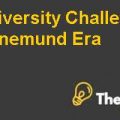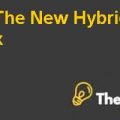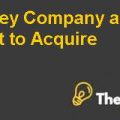Cooper Industries, Inc. Case Solution
VLN Corporation’s Offer
The VLN Company offered to exchange its each preferred stock with each common stock of the Nicholson Company. The preferred stock of VLN Corporation would be paying a dividend of $1.6 per share. These preferred were allowed to be converted into five share of common stock, during the initial year right after the merger. These preferred stock would be callable at a price of $50 per share. Not only this, these stock would have a liquidating value of $50 per share. Additionally, the VLN’s offer included the independent operation of the Nicholson Company and its management.
But as highlighted by the Porter Company, the VLN’s common stock had been sold at a share price of $4.625, which will lead to a value of $23.12 for its preferred stock in the first year. The VLN Company had not paid any dividends since 1970, so converting its preferred stock into common stock would lead to deteriorated financial profitability. Porter should not consider VLN’s offer as the no of shares by VLN Company are very i.e. 14000 as compared to total shares of Nicholson Company i.e. 584000. Cooper Might suffer in the future as conversion of these preferred stock might lead to reduced profitability.
Position of Uncommitted shareholders
The uncommitted shareholder had been holding a portion of 172000 share outstanding. They would follow the advice of Nicholson’s management as they expect an escalation in the acquisition price per share. Therefore, if the offer price by the Cooper Industries can satisfy the concern of the Nicholson management and its uncommitted shareholders, then the cooper Industries would be able to hold a controlling interest in the Nicholson’s Company. As, the market value derived from our calculations is high so the Cooper Industries can offer an acquisition price of $50, which is in line with the Porter’s offer, supporting the merger between Cooper and Nicholson
Recommendations
Based on our calculations which is created by using the free cash flow method, the estimated value per Nicholson share is $ 93.6. It clearly exceeded the market offer to acquire Nicholson shareholders. The valuation was determined because of synergies and some conservative assumptions, although the value of the assumption is quite high, which means that while Nicholson's business survived as a result of the merger with Cooper after 1976, Nicholson's market value should be underestimated, so, the shareholders of Nicholsonwill enjoy benefits from the merger with Cooper.
Case Analysis
The maximum price that Cooper may pay to Nicholson in cash or in the form of shares will depends on the intrinsic value of Nicholson, and Cooper may decide to acquire Nicholson accordingly. If the synergy value of the Cooper acquisition exceeds the bonus paid by Cooper to Nicholson, they can merge. Otherwise, Cooper will have to predict the long-term future of Nicholson’s performance to predict the prospects for the merger.
Synergy is the value achieved by two companies after the merger, such as the difference between the pre-merger value of the two companies and the combined value of the other companies after the merger.
If we can calculate Nicholson’s market value, this will be the highest amount Cooper can pay, because if Cooper pays more than this amount, Cooper’s shareholders will not take benefits from the merger.Therefore, to estimate the value of Nicholson, we evaluate the company using the free cash flow method and therefore determine its value of each stock.
Nicholson’s data in this case has been taken from the year 1967 to 1971 in the income statement, and the balance sheet data from the case which only provides the data of the year 1971. Nicholson’s free cash flow is estimated based on the 1972 forecast to 1976 forecast, including the sustainability of its activities.
In estimating Nicholson’s free cash flow after the merger, the necessary changes due to synergies were included in the assumptions. Thanks to their luck, it was able to try to control Nicholson in May 1972 with the following assumptions.
- Due to the potential profits of each market segment
- Due to the cost of selling goods which can be reduced from 69% to 65%
- Due to the elimination of recurring sales and advertising, selling, general and administrative expenses which has decreased from 22% to 19%
- Currently, the sales ratio in the industrial and consumer markets is the same which is 50:50, and might be offset by the market sales ratio in Nicholson from 50:50 to 75:25
- Due to the use of the European distribution system
- Due to the battle between the VLN and the janitors
Some of the other assumptions have been made which are the
Assumptions belongs to interest expenses:
Because we calculate Nicholson’s free cash flows, interest expense (actually, pre-tax interest and earnings, EBIT) is disregarded in the calculation of pre-tax income (EBT) and then the cost of debt is taken into account in the calculations of the discount cash flow in order to obtain the present value of cash flow.
Assumptions belongs to the retention need for the growth of the company:
If they need resources to pay for the cost of exchanging assets, they must retain some of the cash flow generated by Nicholson in the business. The funds can be used by the cooperative to pay dividends on its shares and can be reused within the company. In the light of the growth of the business, there are essentially resources that need to be preserved. It is assumed that 20% of the cash flow will be used for the above purposes.
Assumptions belongs to the terminal value of the company:
While after 1976, Nicholson and Cooper will operate forever after the merger and grow steadily. In this case, given our current performance, our conservative assumption is a growth rate of 2.00%.
Now, to find the right discount rate, we determine the weighted average cost of capital. For this purpose, provided that the enterprise has no new debt and the cost of equity is determined according to the constant growth model, the cost of debt is calculated.
Nicholson has paid a fixed dividend of $ 1.60 for many years. We assume that the dividend cash flow is $ 1.6 and we assume that D * (1 + g) = D1 = $ 1.6. If Nicholson is able to achieve this growth rate in the post-merger period after achieving synergies, the dividend is expected to grow at a growth rate of 6%, in line with the growth rate of the industry.
This means that if Cooper pays more than $ 54.7 million to Nicholson, Cooper shareholders will suffer losses. On the other hand, if the price paid by Cooper is lower than that price, its shareholders will receive income.
Now considering that Nicholson has a total market capitalization of 584,000 shares and a share price of $ 44. Nicholson’s total market value therefore appears to be $ 25.696 million. Now, if Nicholson’s shareholders get a purchase price that exceeds that value for Cooper, they will be in a better position.
The difference between the market value of $ 25.696 million and $ 54.7 million is the trading range, which is equal to the synergy effect, after the merger we will focus on Nicholson’s valuation.
The use of cash or inventories to raise funds for an acquisition depends on a number of factors that Cooper might consider:
- Overvaluation: If the shares of the acquiring company are overvalued, the cost of using the shares is less than the cost of using the money.
- Taxation: Acquisitions in cash are taxable transactions, while acquisitions in shares are tax-free.
- Revenue Sharing: The use of shares for acquisition might help the shareholders of the acquiring company to make a profit or incur losses, depending on the performance of the company. On the other hand, due to the purchase of money, shareholders receive a fixed price.
For 80% of Nicholson’s equity, Cooper does not have to provide a VLN based on the factors provided by Porter. Therefore, in order to involve speculators and non-shareholders; Cooper can come up with a price that, together with Nicholson’s management, can satisfy these shareholders. Cooper must also consider Porter’s offer of $ 50 per share..........................
Cooper Industries, Inc. Case Solution
This is just a sample partial case solution. Please place the order on the website to order your own originally done case solution.













